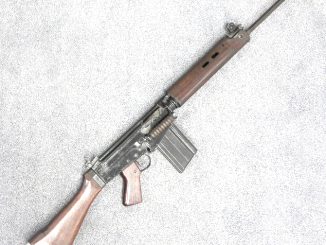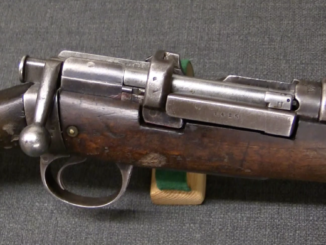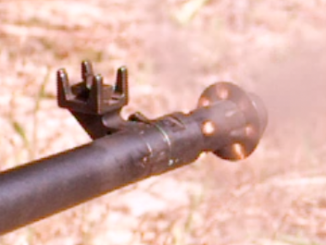Quick, think of the first thing that comes to mind when I say “riot shotgun”!
Does it have a brass buttplate? A tangent rear sight? Is it a single-shot weapon? Does it use a shotshell smaller than 28ga?
No? Well, I guess you have a different notion of riot gear than the Indian military. Huh.
Today I’ve got a video on the Indian answer to the mass-issue riot gun, a SMLE rifle with the magazine well plugged and the barrel bored out to .410. They are pretty neat, and this one’s in really nice shape:
It seems that the bored-out version like mine that use American 2.5″ shells are quite a bit more common here than the original brass-case version here in the States. They’re not too difficult to find if you keep your eyes open online, and not that expensive (yet). Definitely a neat side item for the Enfield collector, or just someone like me who enjoys “different” guns.




Apart from losing the inherent simplicity of single shot and it being considered ‘overkill’ for a police weapon, is there any practical reason for not keeping the gun magazine fed? If they were already using a converted .303 cartridge it would seem it wouldn’t cause any feed issues- or am I missing something?
The Kirkee round is almost cylindrical, and will not feed through a .303 magazine.. getting 7.62×51 to feed is a challenge!
The point of giving guards a shotgun is to limit their capabilty! You need to think “Liberator” logic here – you don’t want to issue a weapon that is too good as you might find it being used against you..
it was made for police & jails, they did’nt trust the 10 rounds-when they came to the U.S.thay taped them out for our410 brass. people thought we coudnot make the brits amo.I gave $200 with bayonet & i shoot 410 slugs.
There were lot of problems in loading those 410 cartridge into the chamber, so they(manufacturers and modifiers) thought to have a single shot follower based rifle would be much more reliable and cheaper than magazine fed versions.
I suspect there are a number of reasons for the .410 SMLE..
It would appear that it was normal practice to have local armed guards on stores and other official buildings in India, but to only issue buckshot loads for these tasks. There were Buckshot loads for both the Snider and the Martini Henry, which were retained for this purpose right up to the 1920s. I would suggest that the example produced in the video would have been converted to replace Martinis when they finally came out of service. Both Kirkee and DumDum produced this shot ammunition, which is relativly easy to do as .303 cordite is necked after the charge is loaded!
.303s are aslo smoothbored in the UK so that people can buy them on a shotgun licence. There are used mostly for re-enactment.
A lot of these were issued in the providence to be used for large animal control . They also made rubber bullets ,(slugs,) for riot control.
Ian, not only do you still find these shotgun conversions in use, I’ve even seen their Martini-Henry predecessors in use at least as late as the early 2000s in Bangladesh/India/Nepal/Burma.
http://images.yuku.com.s3.amazonaws.com/image/pjpeg/bb626ac5d12f37d4b066d2526a8bfc4ab35d125b.pjpg
http://www.martinihenry.com/images4/burmagreener.jpg
I believe a few of the Indian police at Victoria Station (I know, it has an Indian name now) in Bombay (see previous parenths) were armed with these when the Lashkar-e Taiba goons came in blazing with AKs. Most of them were even more underarmed, carrying only a lathi (big baton or small staff). The cops bugged out, mostly.
Are these the ones with the distinctive three pronged firing pin and matching primer??? Which I’ve only read about and have never seen???
CB in FL
I believe you’re thinking of the Greener shotguns made from Martini actions, which had a number of elements in their design to prevent their use if captured or stolen. When I can get my hands on one of those, I will definitely be doing a video on it.
That’s the one!!!
*Shudder*. I would definitely not want to confront an AK with one of these…
I remember when Springfield Sporters in Penn Run, PA used to have a retail shop back in the late 80’s, early 90’s. Me and my buddies went up a couple times a year and they used to have racks of these in full military trim and sporterized for about $59. Like many other things I passed on in the day I wish I would have gotten one of them then 🙂
A crew served .410 SMLE. Only on Forgotten Weapons. My father recalled versions being used in the backwoods of Vermont and New Hampshire just after the war. He said the only thing they had going for them was cheap and sturdy. They were generally employed as squirrel guns or to shoot varmints in the barn yard. It seems the .410SMLE didn’t swing good enough for moving targets.
Som ofyhese 410 guns werw sold in Denmark,with a modified magasine taking a 2 inch 410 caetridge. at that time no permision for smoothbore long guns, were needed, so they sold as icsceeme on a hot sommer day. the agent also sold some Rss rifles conwerted ths ame way, both, handled 410 slugs nicely
I suspect “GRI” is for “Georgius Rex Imperator”.
http://en.wikipedia.org/wiki/Georgius_Rex_Imperator
Yeah, it is. My mistake!
I have to echo Matt’s acknowledgement of the FW crew-served .410 Lee-Enfield – makes this thing almost dangerous, eh? 😛
India is very densely populated and FMJ 303s are too dangerous in a police situation.The .410 was issued as a shot round with both rubber bullets and solid lead projectiles were made for defense against two and four legged beasts.It was also difficult for India to issue rifled weapons to civilians until relatively modern times. Ghandi reportedly said “The greatest sin of the English was to totally disarm an entire country”
Who needs a ten-round mag when you’ve got a bunch of friends standing next to you? Most entertaining 🙂
The loader is supposed to yell, “UP!” when he’s finished so the gunner knows he can take over.
The gunner is supposed to say “on the way,” before firing, not “bloody hell”.
So…who’s gonna build a .410 Vickers so Ian can make the worlds most brutal skeet shooting video? Come on, someone…please… You know you want to see it as bad as I do! 🙂
I’m game. 🙂
Feeding would be tricky, because of the blunt nose of the shell. That’s why Joel is saying “bloody hell” at the end of the video – three rounds in a row that jammed against the barrel face instead of chambering (the trick is to actually slide the round a bit into the chamber by hand, rather than just dropping it on the follower).
However, if one were to use the British style brass shells instead of standard .410 ammo, the .303 extractor would work perfectly. Dunno about the feed block; it would probably need to be opened up to accommodate the straight neck of the shell. And, of course, a barrel would have to be reamed out to .410. A 360 degree chamfer could probably be made in the chamber to help feeding, with the .410 pressure being low enough to not cause problems with less-supported brass. It almost sounds like making the ammo would be the hardest part. And I do have a Vickers already…hmm…
How many skeet ranges do you think have had the foresight to make a rule against using tripods? 😉
This project reminds me of the creative “kits” to build various fascinating mutations and imaginative variations of different weapons I remember from old SARCO ad’s back when they still had 3.5 metric tons of every surplus rifle and machine gun part known to man.
(SHOT OUT 20mm TORCH CUT BBL SECTIONS!
Build your own tripod mount black powder cannon!
500 furnace-recovered 20mm tracer slugs AND Crushed T&E unit included! only $99)
… And honestly, this sounds easier and more practical from a modification standpoint than many of the projects they envisioned and described in all that wonderful tiny print.
As far as the ammo goes, I wonder if these could be made to work?
http://www.ballisticproducts.com/MagTech-410-2-1_2-empty-brass-shotshells-for-reloading/productinfo/3924165/
I seem to remember someone selling factory-loaded brass case .410 not too long ago, but I can’t recall who…
I’m guessing most ranges would jump at the chance to host such a demo. You can’t buy publicity like that.
I can just almost see this amazing toy in my minds eye…. Where’s my Visene!
There is a long history of issuing “natives” with less capable guns.
Back at the time of the three band Enfield, “native” troops were issued with a smoothbore version, so that in the event of a “mutiny” / attempt to liberate themselves, they were less capable of long range accurate fire than the Brits, who were armed with the genuine rifled bore version.
The Greener martini action riot shotguns were particularly interesting. First of all the large martini action had its geometry altered to allow the loading of a larger diameter case, the hole for the barrel was re bored, to raise the muzzle, so that the pivot pin for the breech block lined up with the central axis of the bore (the pin lies above the bore axis in the original .577/.450 and the .303 rebarrelled rifles). I’ll see if I can look out the Greener patent covering the altered geometry.
To prevent the cops from stealing work cartridges to use in stolen sporting guns, or stealing sporting cartridges to use in a works gun, the riot guns were thirteen guage rather than twelve guage – a twelve guage case wouldn’t chamber.
Just to be extra sure, the 13g cases were not manufactured to be centre fire.
The primer had a hard, inert centre, and the sensitive area formed a ring around that centre. The Martini breech block had a pair of firing pins formed at the end, and these struck slightly off centre, making sure that ammunition could not be interchanged with a sporting 12 guage.
Greener also made 12 guage police and sporting guns on the martini action.
Back in the mid 1970s I remember seeing sporterized lee actioned .410 shotguns for sale in Britain for around £20 to £25.
Shotguns were first subjected to licensing from 1968, and up until either 1988 or 1997, shotgun certificates were on a “shall issue” basis, a far cry from rifles which had been licensed since around 1920 and you had to convince the chief constable of your county that you had “good reason” for each one you wanted.
There was therefore a much larger potential market for “shotguns” than rifles when the British bureaucrats began to treat the British population as potentially mutinous subjects of empire.
Conversion of .303 rifles to .410 was a relatively easy process, as both cases share the same head dimensions, and, as the .303 is relatively tapered, the boring out and rechambering could clean out a very pitted bore, making a scrap barrel saleable.
Nearly right!
The Mk III Greener cartridge had an annular groove around the primer which mated with a couple of pegs on the breech face, which prevented you from chambering a conventional cartridge..
See Here: http://www.dave-cushman.net/shot/greenerpolice.html
sorry, I got the geometry for the 12 and 13 guage martinis wrong, the muzzle of the barrel was dropped relative to the original rifle version.
Actually the “I” in GRI is Georgius Rex – Imperator…George the King and EMPEROR – that making was unique to the Ishapore produced rifles and was the stamp on the butt socket until 1950 that the Royal Cypher was replaced with the Indian Ashoka – the three lion stamp…Indian Independence was proclaimed ob 14 Aug 1947 but the Royal Cypher remained for almost three years….I have a 1948 Ishy with the RFI and initrially thought it strange that it would remain past Independence, but it wasn’t[t replaced until after the country was proclaimed a republic on 1 Jan 1950.
CB in FL
McThag – you must be a tanker!!! GUNNER!!! HEAT!!! Tank!!! Identified!!!….
CB in FL
Reminds me of the Geha conversions done in the 1920s to leftover german gewehr 98 rifles.
This has me wondering, Hey Ian, you ever get a chance to shoot the Martini-Greened Police gun? (It’s the 12/13 GA mentioned in an above post) Like many surplus firearm they were…”All over the place and cheep a few years ago”…..
I’ve run across a couple, but not had the chance to shoot one (yet). It’s a piece I would like to add to my own collection, when I can find one at the right price…
CLICK – BLOODY HELL!
CLICK – BLOODY HELL!
CLICK CLICK – BLOODY HELL!
Now the funniest video segment on FW.
One of the advantages of this sort of conversion is that the firearm is quite robust so you can use it as a club if necessary. The Greener riot shotgun was also heavily constructed for this reason. You can reverse the weapon and use the brass but plate to good effect at close range to push (batter) back crowds.
The advantage of a proprietary shot shell is that stolen (or illegally sold) shotguns are difficult to get shells for. This reduces the incentive to steal (or sell) these weapons.
The limited lethality of these weapons is a feature, not a problem. Putting down riots doesn’t normally involve massacring the participants. If things were really serious, you would be using normal rifles.
it was kept to smoothbore single shot to keep the Indian shape shooter, out shooting the british and under powering the Indians. Old stock for the Indians.
Will the Isphapore .410 shoot a .45 colt round?